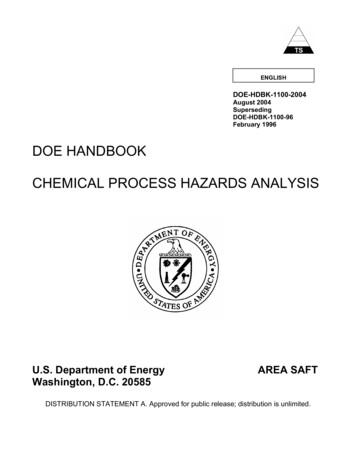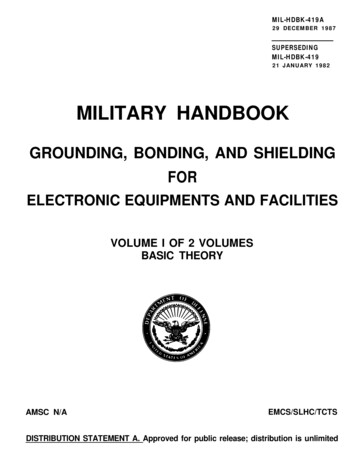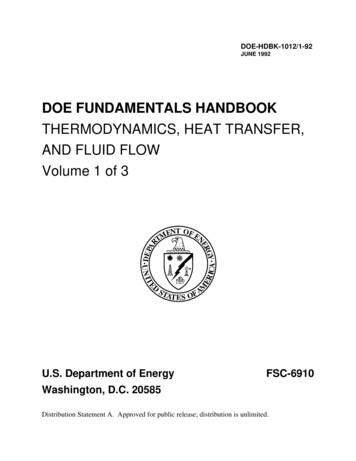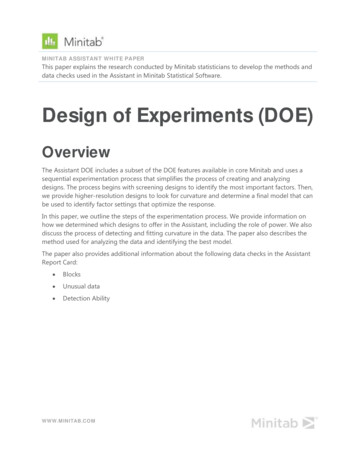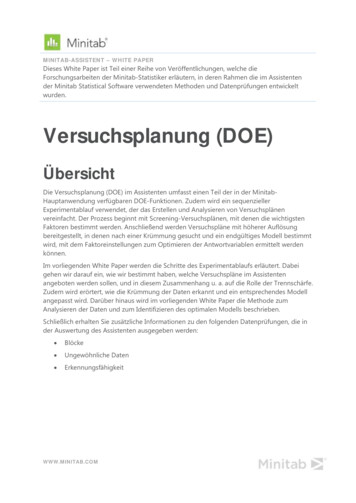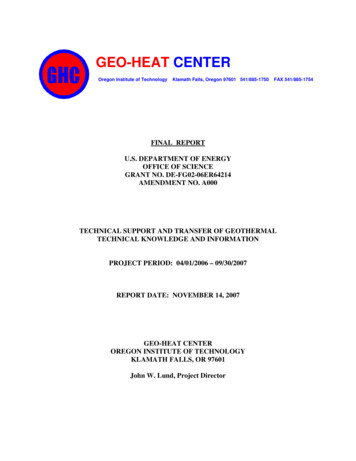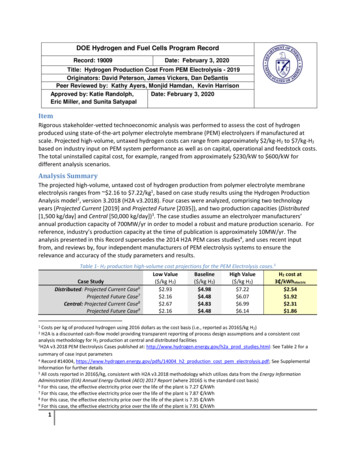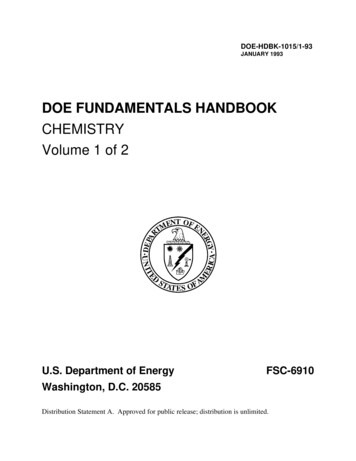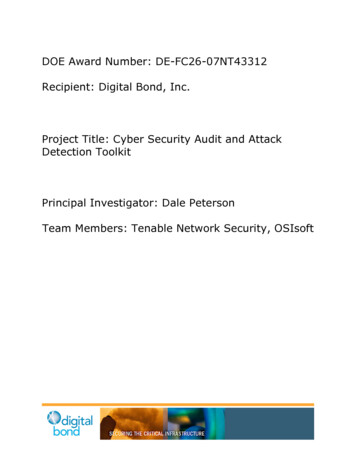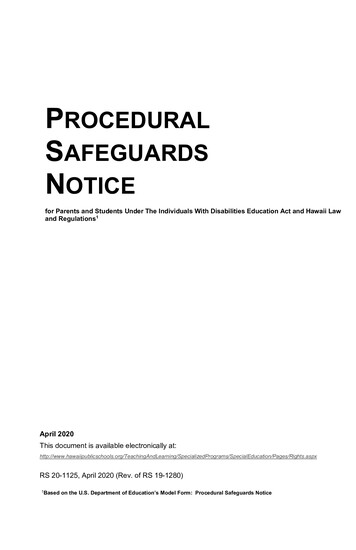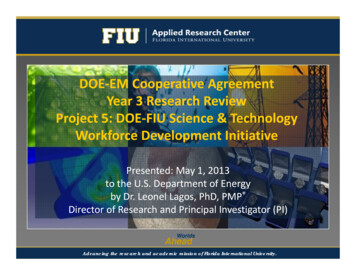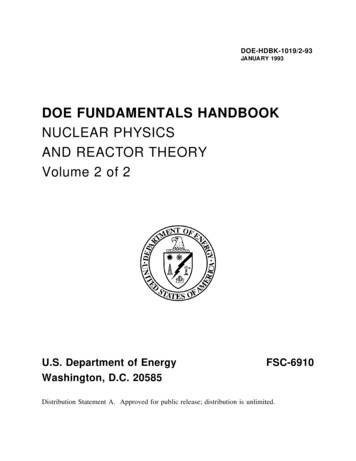
Transcription
DOE-HDBK-1019/2-93JANUARY 1993DOE FUNDAMENTALS HANDBOOKNUCLEAR PHYSICSAND REACTOR THEORYVolume 2 of 2U.S. Department of EnergyWashington, D.C. 20585FSC-6910Distribution Statement A. Approved for public release; distribution is unlimited.
This document has been reproduced directly from the best available copy.Available to DOE and DOE contractors from the Office of Scientific andTechnical Information, P.O. Box 62, Oak Ridge, TN 37831.Available to the public from the National Technical Information Service, U.S.Department of Commerce, 5285 Port Royal., Springfield, VA 22161.Order No. DE93012223
DOE-HDBK-1019/1-93NUCLEAR PHYSICS AND REACTOR THEORYABSTRACTThe Nuclear Physics and Reactor Theory Handbook was developed to assist nuclearfacility operating contractors in providing operators, maintenance personnel, and the technicalstaff with the necessary fundamentals training to ensure a basic understanding of nuclear physicsand reactor theory. The handbook includes information on atomic and nuclear physics; neutroncharacteristics; reactor theory and nuclear parameters; and the theory of reactor operation. Thisinformation will provide personnel with a foundation for understanding the scientific principlesthat are associated with various DOE nuclear facility operations and maintenance.Key Words: Training Material, Atomic Physics, The Chart of the Nuclides, Radioactivity,Radioactive Decay, Neutron Interaction, Fission, Reactor Theory, Neutron Characteristics,Neutron Life Cycle, Reactor KineticsRev. 0NP
DOE-HDBK-1019/1-93NUCLEAR PHYSICS AND REACTOR THEORYF OREWOR DThe Department of Energy (DOE) Fundamentals Handbooks consist of ten academicsubjects, which include Mathematics; Classical Physics; Thermodynamics, Heat Transfer, andFluid Flow; Instrumentation and Control; Electrical Science; Material Science; MechanicalScience; Chemistry; Engineering Symbology, Prints, and Drawings; and Nuclear Physics andReactor Theory. The handbooks are provided as an aid to DOE nuclear facility contractors.These handbooks were first published as Reactor Operator Fundamentals Manuals in 1985for use by DOE category A reactors. The subject areas, subject matter content, and level ofdetail of the Reactor Operator Fundamentals Manuals were determined from several sources.DOE Category A reactor training managers determined which materials should be included, andserved as a primary reference in the initial development phase. Training guidelines from thecommercial nuclear power industry, results of job and task analyses, and independent input fromcontractors and operations-oriented personnel were all considered and included to some degreein developing the text material and learning objectives.The DOE Fundamentals Handbooks represent the needs of various DOE nuclear facilities'fundamental training requirements. To increase their applicability to nonreactor nuclear facilities,the Reactor Operator Fundamentals Manual learning objectives were distributed to the NuclearFacility Training Coordination Program Steering Committee for review and comment. To updatetheir reactor-specific content, DOE Category A reactor training managers also reviewed andcommented on the content. On the basis of feedback from these sources, information that appliedto two or more DOE nuclear facilities was considered generic and was included. The final draftof each of the handbooks was then reviewed by these two groups. This approach has resultedin revised modular handbooks that contain sufficient detail such that each facility may adjust thecontent to fit their specific needs.Each handbook contains an abstract, a foreword, an overview, learning objectives, andtext material, and is divided into modules so that content and order may be modified byindividual DOE contractors to suit their specific training needs. Each handbook is supported bya separate examination bank with an answer key.The DOE Fundamentals Handbooks have been prepared for the Assistant Secretary forNuclear Energy, Office of Nuclear Safety Policy and Standards, by the DOE TrainingCoordination Program. This program is managed by EG&G Idaho, Inc.Rev. 0NP
DOE-HDBK-1019/1-93NUCLEAR PHYSICS AND REACTOR THEORYOVERVIEWThe Department of Energy Fundamentals Handbook entitled Nuclear Physics and ReactorTheory was prepared as an information resource for personnel who are responsible for theoperation of the Department's nuclear facilities. Almost all processes that take place in a nuclearfacility involves the transfer of some type of energy. A basic understanding of nuclear physicsand reactor theory is necessary for DOE nuclear facility operators, maintenance personnel, andthe technical staff to safely operate and maintain the facility and facility support systems. Theinformation in this handbook is presented to provide a foundation for applying engineeringconcepts to the job. This knowledge will help personnel understand the impact that their actionsmay have on the safe and reliable operation of facility components and systems.The Nuclear Physics and Reactor Theory handbook consists of four modules that arecontained in two volumes. The following is a brief description of the information presented ineach module of the handbook.Volume 1 of 2Module 1 - Atomic and Nuclear PhysicsIntroduces concepts of atomic physics including the atomic nature of matter, thechart of the nuclides, radioactivity and radioactive decay, neutron interactions andfission, and the interaction of radiation with matter.Module 2 - Reactor Theory (Nuclear Parameters)Provides information on reactor theory and neutron characteristics. Includestopics such as neutron sources, neutron flux, neutron cross sections, reaction rates,neutron moderation, and prompt and delayed neutrons.Rev. 0NP
DOE-HDBK-1019/1-93NUCLEAR PHYSICS AND REACTOR THEORYOVERVIEW (Cont.)Volume 2 of 2Module 3 - Reactor Theory (Nuclear Parameters)Explains the nuclear parameters associated with reactor theory. Topics includethe neutron life cycle, reactivity and reactivity coefficients, neutron poisons, andcontrol rods.Module 4 - Reactor Theory (Reactor Operations)Introduces the reactor operations aspect of reactor theory. Topics includesubcritical multiplication, reactor kinetics, and reactor operation.The information contained in this handbook is not all-encompassing. An attempt topresent the entire subject of nuclear physics and reactor theory would be impractical. However,the Nuclear Physics and Reactor Theory handbook presents enough information to provide thereader with the fundamental knowledge necessary to understand the advanced theoreticalconcepts presented in other subject areas, and to understand basic system and equipmentoperation.Rev. 0NP
Department of EnergyFundamentals HandbookNUCLEAR PHYSICSAND REACTOR THEORYM odule 3Reactor Theory (Nuclear Parameters)
Reactor Theory (Nuclear Parameters)DOE-HDBK-1019/2-93TABLE OF CONTENTSTABLE OF C ONTENTSLIST OF FIGURES . . . . . . . . . . . . . . . . . . . . . . . . . . . . . . . . . . . . . . . . . . . . . . . . iiiLIST OF TABLES . . . . . . . . . . . . . . . . . . . . . . . . . . . . . . . . . . . . . . . . . . . . . . . . . ivREFERENCES . . . . . . . . . . . . . . . . . . . . . . . . . . . . . . . . . . . . . . . . . . . . . . . . . . .vOBJECTIVES . . . . . . . . . . . . . . . . . . . . . . . . . . . . . . . . . . . . . . . . . . . . . . . . . . . . viNEUTRON LIFE CYCLE . . . . . . . . . . . . . . . . . . . . . . . . . . . . . . . . . . . . . . . . . . . .Infinite Multiplication Factor, k . . . . . . . . . . . . . . . . . . . . . . . . . . . . . .Four Factor Formula . . . . . . . . . . . . . . . . . . . . . . . . . . . . . . . . . . . . .Fast Fission Factor, ( ) . . . . . . . . . . . . . . . . . . . . . . . . . . . . . . . . . . .Resonance Escape Probability, (p) . . . . . . . . . . . . . . . . . . . . . . . . . . .Thermal Utilization Factor, (f) . . . . . . . . . . . . . . . . . . . . . . . . . . . . . .Reproduction Factor, (η) . . . . . . . . . . . . . . . . . . . . . . . . . . . . . . . . . .Effective Multiplication Factor . . . . . . . . . . . . . . . . . . . . . . . . . . . . . .Fast Non-Leakage Probability ( f) . . . . . . . . . . . . . . . . . . . . . . . . . . .Thermal Non-Leakage Probability ( t) . . . . . . . . . . . . . . . . . . . . . . . . .Six Factor Formula . . . . . . . . . . . . . . . . . . . . . . . . . . . . . . . . . . . . . .Neutron Life Cycle of a Fast Reactor . . . . . . . . . . . . . . . . . . . . . . . . .Summary . . . . . . . . . . . . . . . . . . . . . . . . . . . . . . . . . . . . . . . . . . . . 2. 2. 3. 3. 4. 6. 8. 9. 9. . 10. . 14. . 14REACTIVITY . . . . . . . . . . . . . . . . . . . . . . . . . . . . . . . . . . . . . . . . . . . . . . . . . . .Application of the Effective Multiplication FactorReactivity . . . . . . . . . . . . . . . . . . . . . . . . . . .Units of Reactivity . . . . . . . . . . . . . . . . . . . . .Reactivity Coefficients and Reactivity Defects . .Summary . . . . . . . . . . . . . . . . . . . . . . . . . . .1718192122REACTIVITY COEFFICIENTS . . . . . . . . . . . . . . . . . . . . . . . . . . . . . . . . . . . . . . .23Rev. 0.Page i.17.Moderator Effects . . . . . . . . . . . .Moderator Temperature CoefficientFuel Temperature Coefficient . . . .Pressure Coefficient . . . . . . . . . .Void Coefficient . . . . . . . . . . . . .Summary . . . . . . . . . . . . . . . . .1.242626272728NP-03
TABLE OF CONTENTSDOE-HDBK-1019/2-93Reactor Theory (Nuclear Parameters)TABLE OF C ONTENTS (Cont.)NEUTRON POISONS . . . . . . . . . . . . . . . . . . . . . . . . . . . . . . . . . . . . . . . . . . . . .Fixed Burnable PoisonsSoluble Poisons . . . . .Non-Burnable Poisons .Summary . . . . . . . . .30313233XENON . . . . . . . . . . . . . . . . . . . . . . . . . . . . . . . . . . . . . . . . . . . . . . . . . . . . . . .34Fission Product Poisons . . . . . . . . . . . . . . . . .Production and Removal of Xenon-135 . . . . . .Xenon-135 Response to Reactor Shutdown . . . .Xenon-135 Oscillations . . . . . . . . . . . . . . . . .Xenon-135 Response to Reactor Power ChangesSummary . . . . . . . . . . . . . . . . . . . . . . . . . .NP-03Page ii.48.CONTROL RODS . . . . . . . . . . . . . . . . . . . . . . . . . . . . . . . . . . . . . . . . . . . . . . . .43454647.Selection of Control Rod Materials . . . . . .Types of Control Rods . . . . . . . . . . . . . .Control Rod Effectiveness . . . . . . . . . . . .Integral and Differential Control Rod WorthRod Control Mechanisms . . . . . . . . . . . .Summary . . . . . . . . . . . . . . . . . . . . . . .43.SAMARIUM AND OTHER FISSION PRODUCT POISONS . . . . . . . . . . . . . . . . . . .343538394041.Production and Removal of Samarium-149 . . .Samarium-149 Response to Reactor ShutdownOther Neutron Poisons . . . . . . . . . . . . . . . .Summary . . . . . . . . . . . . . . . . . . . . . . . . .30.484950515757Rev. 0
Reactor Theory (Nuclear Parameters)DOE-HDBK-1019/2-93LIST OF FIGURESLIST OF FIGURESFigure 1Neutron Life Cycle with keff 1 . . . . . . . . . . . . . . . . . . . . . . . . . . . . . . . . 11Figure 2Effects of Over and Under Moderation on keff . . . . . . . . . . . . . . . . . . . . . . . 25Figure 3Effect of Fuel Temperature on Resonance Absorption Peaks . . . . . . . . . . . . . 27Figure 4Equilibrium Iodine-135 and Xenon-135 Concentrations Versus Neutron Flux . . 37Figure 5Xenon-135 Reactivity After Reactor Shutdown . . . . . . . . . . . . . . . . . . . . . . 38Figure 6Xenon-135 Variations During Power Changes . . . . . . . . . . . . . . . . . . . . . . . 40Figure 7Behavior of Samarium-149 in a Typical Light Water Reactor . . . . . . . . . . . . . 46Figure 8Effect of Control Rod on Radial Flux Distribution . . . . . . . . . . . . . . . . . . . . 50Figure 9Integral Control Rod Worth . . . . . . . . . . . . . . . . . . . . . . . . . . . . . . . . . . . 51Figure 10 Differential Control Rod Worth . . . . . . . . . . . . . . . . . . . . . . . . . . . . . . . . . 52Figure 11 Rod Worth Curves for Example Problems . . . . . . . . . . . . . . . . . . . . . . . . . 53Figure 12 Rod Worth Curves From Example 3 . . . . . . . . . . . . . . . . . . . . . . . . . . . . . 56Rev. 0Page iiiNP-03
LIST OF TABLESDOE-HDBK-1019/2-93Reactor Theory (Nuclear Parameters)LIST OF TABLESTable 1 Average Number of Neutrons Liberated in Fission . . . . . . . . . . . . . . . . . . . . . . 7NP-03Page ivRev. 0
Reactor Theory (Nuclear oster, Arthur R. and Wright, Robert L. Jr., Basic Nuclear Engineering, 3rd Edition, Allynand Bacon, Inc., 1977.Jacobs, A.M., Kline, D.E., and Remick, F.J., Basic Principles of Nuclear Science andReactors, Van Nostrand Company, Inc., 1960.Kaplan, Irving, Nuclear Physics, 2nd Edition, Addison-Wesley Company, 1962.Knief, Ronald Allen, Nuclear Energy Technology: Theory and Practice of CommercialNuclear Power, McGraw-Hill, 1981.Lamarsh, John R., Introduction to Nuclear Engineering, Addison-Wesley Company, 1977.Lamarsh, John R., Introduction to Nuclear Reactor Theory, Addison-Wesley Company,1972.General Electric Company, Nuclides and Isotopes: Chart of the Nuclides, 14th Edition,General Electric Company, 1989.Academic Program for Nuclear Power Plant Personnel, Volume III, Columbia, MD,General Physics Corporation, Library of Congress Card #A 326517, 1982.Glasstone, Samuel, Sourcebook on Atomic Energy, Robert F. Krieger PublishingCompany, Inc., 1979.Glasstone, Samuel and Sesonske, Alexander, Nuclear Reactor Engineering, 3rd Edition,Van Nostrand Reinhold Company, 1981.Rev. 0Page vNP-03
OBJECTIVESDOE-HDBK-1019/2-93Reactor Theory (Nuclear Parameters)TERMINAL OBJECTIVE1.0Using appropriate references, DESCRIBE the neutron life cycle discussed in thismodule.ENABLING OBJECTIVE S1.1DEFINE the following terms:a.b.c.d.e.1.2Infinite multiplication factor, k Effective multiplication factor, keffSubcriticalCriticalSupercriticalDEFINE each term in the six factor formula using the ratio of the number of neutronspresent at different points in the neutron life cycle.1.3Given the macroscopic cross sections for various materials, CALCULATE the thermalutilization factor.1.4Given microscopic cross sections for absorption and fission, atom density, and ν,CALCULATE the reproduction factor.1.5Given the numbers of neutrons present at the start of a generation and values for eachfactor in the six factor formula, CALCULATE the number of neutrons that will bepresent at any point in the life cycle.1.6LIST physical changes in the reactor core that will have an effect on the thermalutilization factor, reproduction factor, or resonance escape probability.1.7EXPLAIN the effect that temperature changes will have on the following factors:a.b.c.d.1.8NP-03Thermal utilization factorResonance escape probabilityFast non-leakage probabilityThermal non-leakage probabilityGiven the number of neutrons in a reactor core and the effective multiplication factor,CALCULATE the number of neutrons present after any number of generations.Page viRev. 0
Reactor Theory (Nuclear Parameters)DOE-HDBK-1019/2-93OBJECTIVESENABLING OBJECTIVES (Cont.)1.9DEFINE the term reactivity.1.10CONVERT between reactivity and the associated value of keff.1.11CONVERT measures of reactivity between the following units:a.b. k/k% k/kc.d.10-4 k/kPercent millirho (pcm)1.12EXPLAIN the relationship between reactivity coefficients and reactivity defects.Rev. 0Page viiNP-03
OBJECTIVESDOE-HDBK-1019/2-93Reactor Theory (Nuclear Parameters)TERMINAL OBJECTIVE2.0From memory, EXPLAIN how reactivity varies with the thermodynamic properties ofthe moderator and the fuel.ENABLING OBJECTIVE S2.1EXPLAIN the conditions of over moderation and under moderation.2.2EXPLAIN why many reactors are designed to be operated in an under moderatedcondition.2.3STATE the effect that a change in moderator temperature will have on the moderator tofuel ratio.2.4DEFINE the temperature coefficient of reactivity.2.5EXPLAIN why a negative temperature coefficient of reactivity is desirable.2.6EXPLAIN why the fuel temperature coefficient is more effective than the moderatortemperature coefficient in terminating a rapid power rise.2.7EXPLAIN the concept of Doppler broadening of resonance absorption peaks.2.8LIST two nuclides that are present in some types of reactor fuel assemblies that havesignificant resonance absorption peaks.2.9DEFINE the pressure coefficient of reactivity.2.10EXPLAIN why the pressure coefficient of reactivity is usually negligible in a reactorcooled and moderated by a subcooled liquid.2.11DEFINE the void coefficient of reactivity.2.12IDENTIFY the moderator conditions under which the void coefficient of reactivitybecomes significant.NP-03Page viiiRev. 0
Reactor Theory (Nuclear Parameters)DOE-HDBK-1019/2-93OBJECTIVESTERMINAL OBJECTIVE3.0Without references, DESCRIBE the use of neutron poisons.ENABLING OBJECTIVE S3.1DEFINE the following terms:a.b.c.Burnable poisonNon-burnable poisonChemical shim3.2EXPLAIN the use of burnable neutron poisons in a reactor core.3.3LIST the advantages and disadvantages of chemical shim over fixed burnable poisons.3.4STATE two reasons why fixed non-burnable neutron poisons are used in reactor cores.3.5STATE an example of a material used as a fixed non-burnable neutron poison.Rev. 0Page ixNP-03
OBJECTIVESDOE-HDBK-1019/2-93Reactor Theory (Nuclear Parameters)TERMINAL OBJECTIVE4.0Without references, DESCRIBE the effects of fission product poisons on a reactor.ENABLING OBJECTIVE S4.1LIST two methods of production and two methods of removal for xenon-135 duringreactor operation.4.2STATE the equation for equilibrium xenon-135 concentration.4.3DESCRIBE how equilibrium xenon-135 concentration varies with reactor power level.4.4DESCRIBE the causes and effects of a xenon oscillation.4.5DESCRIBE how xenon-135 concentration changes following a reactor shutdown fromsteady-state conditions.4.6EXPLAIN the effect that pre-shutdown power levels have on the xenon-135concentration after shutdown.4.7STATE the approximate time following a reactor shutdown at which the reactor can beconsidered "xenon free."4.8EXPLAIN what is meant by the following terms:a.b.4.9Xenon precluded startupXenon dead timeDESCRIBE how xenon-135 concentration changes following an increase or a decreasein the power level of a reactor.4.10DESCRIBE how samarium-149 is produced and removed from the reactor core duringreactor operation.4.11STATE the equation for equilibrium samarium-149 concentration.4.12DESCRIBE how equilibrium samarium-149 concentration varies with reactor powerlevel.NP-03Page xRev. 0
Reactor Theory (Nuclear Parameters)DOE-HDBK-1019/2-93OBJECTIVESENABLING OBJECTIVES (Cont.)4.13DESCRIBEhow samarium-149 concentrationshutdown from steady-state conditions.changesfollowingareactor4.14DESCRIBE how samarium-149 concentration changes following a reactor startup.4.15STATE the conditions under which helium-3 will have a significant effect on thereactivity of a reactor.Rev. 0Page xiNP-03
OBJECTIVESDOE-HDBK-1019/2-93Reactor Theory (Nuclear Parameters)TERMINAL OBJECTIVE5.0Without references, DESCRIBE how control rods affect the reactor core.ENABLING OBJECTIVE S5.1DESCRIBE the difference between a "grey" neutron absorbing material and a "black"neutron absorbing material.5.2EXPLAIN why a "grey" neutron absorbing material may be preferable to a "black"neutron absorbing material for use in control rods.5.3EXPLAIN why resonance absorbers are sometimes preferred over thermal absorbers asa control rod material.5.4DEFINE the following terms:a.b.5.5Integral control rod worthDifferential control rod worthDESCRIBE the shape of a typical differential control rod worth curve and explain thereason for the shape.5.6DESCRIBE the shape of a typical integral control rod worth curve and explain the reasonfor the shape.5.7Given an integral or differential control rod worth curve, CALCULATE the reactivitychange due to a control rod movement between two positions.5.8Given differential control rod worth data, PLOT differential and integral control rodworth curves.NP-03Page xiiRev. 0
Reactor Theory (Nuclear Parameters)DOE-HDBK-1019/2-93NEUTRON LIFE CYCLENEUTRON LIFE C YCLESome number of the fast neutrons produced by fission in one generation willeventually cause fission in the next generation. The series of steps that fissionneutrons go through as they slow to thermal energies and are absorbed in thereactor is referred to as the neutron life cycle. The neutron life cycle is markedlydifferent between fast reactors and thermal reactors. This chapter presents theneutron life cycle for thermal reactors.EO 1.1DEFINE the following terms:a.b.c.d.e.CriticalSupercriticalEO 1.2DEFINE each term in the six factor formula using the ratio ofthe num ber of neutrons present at different points in theneutron life cycle.EO 1.3Given the macroscopic cross sections for various materials,CALCULATE the thermal utilization factor.EO 1.4Given m icroscopic cross sections for absorption and fission,atom density, and ν, CALCULATE the reproduction factor.EO 1.5Given the numbers of neutrons present at the start of a generationand values for each factor in the six factor formula, CALCULATE thenum ber of neutrons that will be present at any point in the lifecycle.EO 1.6LIST physical changes in the reactor core that will have an effecton the thermal utilization factor, reproduction factor, orresonance escape probability.EO 1.7EXPLAIN the effect that temperature changes will have on thefollowing factors:a.b.c.d.Rev. 0Infinite multiplication factor, k Effective multiplication factor, k effSubcriticalThermal utilization factorResonance escape probabilityFast non-leakage probabilityThermal non-leakage probabilityPage 1NP-03
NEUTRON LIFE CYCLEDOE-HDBK-1019/2-93Reactor Theory (Nuclear Parameters)Infinite M ultiplication Factor, k Not all of the neutrons produced by fission will have the opportunity to cause new fissionsbecause some neutrons will be absorbed by non-fissionable material. Some will be absorbedparasitically in fissionable material and will not cause fission, and others will leak out of thereactor. For the maintenance of a self-sustaining chain reaction, however, it is not necessarythat every neutron produced in fission initiate another fission. The minimum condition is foreach nucleus undergoing fission to produce, on the average, at least one neutron that causesfission of another nucleus. This condition is conveniently expressed in terms of a multiplicationfactor.The number of neutrons absorbed or leaking out of the reactor will determine the value of thismultiplication factor, and will also determine whether a new generation of neutrons is larger,smaller, or the same size as the preceding generation. Any reactor of a finite size will haveneutrons leak out of it. Generally, the larger the reactor, the lower the fraction of neutronleakage. For simplicity, we will first consider a reactor that is infinitely large, and thereforehas no neutron leakage. A measure of the increase or decrease in neutron flux in an infinitereactor is the infinite multiplication factor, k . The infinite multiplication factor is the ratio ofthe neutrons produced by fission in one generation to the number of neutrons lost throughabsorption in the preceding generation. This can be expressed mathematically as shown below.k neutron production from fission in one generationneutron absorption in the preceding generationFour Factor FormulaA group of fast neutrons produced by fission can enter into several reactions. Some of thesereactions reduce the size of the neutron group while other reactions allow the group to increasein size or produce a second generation. There are four factors that are completely independentof the size and shape of the reactor that give the inherent multiplication ability of the fuel andmoderator materials without regard to leakage. This four factor formula accurately represents theinfinite multiplication factor as shown in the equation below.k pfηwhere: p f η fast fission factorresonance escape probabilitythermal utilization factorreproduction factorEach of these four factors, which are explained in the following subsections, represents a process thatadds to or subtracts from the initial neutron group produced in a generation by fission.NP-03Page 2Rev. 0
Reactor Theory (Nuclear Parameters)DOE-HDBK-1019/2-93NEUTRON LIFE CYCLEFast Fission Factor, ( )The first process that the neutrons of one generation may undergo is fast fission. Fast fissionis fission caused by neutrons that are in the fast energy range. Fast fission results in the netincrease in the fast neutron population of the reactor core. The cross section for fast fission inuranium-235 or uranium-238 is small; therefore, only a small number of fast neutrons causefission. The fast neutron population in one generation is therefore increased by a factor calledthe fast fission factor. The fast fission factor ( ) is defined as the ratio of the net number of fastneutrons produced by all fissions to the number of fast neutrons produced by thermal fissions.The mathematical expression of this ratio is shown below.number of fast neutrons produced by all fissionsnumber of fast neutrons produced by thermal fissionsIn order for a neutron to be absorbed by a fuel nucleus as a fast neutron, it must pass closeenough to a fuel nucleus while it is a fast neutron. The value of will be affected by thearrangement and concentrations of the fuel and the moderator. The value of is essentially 1.00for a homogenous reactor where the fuel atoms are surrounded by moderator atoms. However,in a heterogeneous reactor, all the fuel atoms are packed closely together in elements such aspins, rods, or pellets. Neutrons emitted from the fission of one fuel atom have a very goodchance of passing near another fuel atom before slowing down significantly. The arrangementof the core elements results in a value of about 1.03 for in most heterogeneous reactors. Thevalue of is not significantly affected by variables such as temperature, pressure, enrichment,or neutron poison concentrations. Poisons are non-fuel materials that easily absorb neutrons andwill be discussed in more detail later.Resonance Escape Probability, (p)After increasing in number as a result of some fast fissions, the neutrons continue to diffusethrough the reactor. As the neutrons move they collide with nuclei of fuel and non-fuel materialand moderator in the reactor losing part of their energy in each collision and slowing down.While they are slowing down through the resonance region of uranium-238, which extends fromabout 6 eV to 200 eV, there is a chance that some neutrons will be captured. The probabilitythat a neutron will not be absorbed by a resonance peak is called the resonance escapeprobability. The resonance escape probability (p) is defined as the ratio of the number ofneutrons that reach thermal energies to the number of fast neutrons that start to slow down. Thisratio is shown below.pRev. 0number of neutrons that reach thermal energynumber of fast neutrons that start to slow downPage 3NP-03
NEUTRON LIFE CYCLEDOE-HDBK-1019/2-93Reactor Theory (Nuclear Parameters)The value of the resonance escape probability is determined largely by the fuel-moderatorarrangement and the amount of enrichment of uranium-235 (if any is used). To undergoresonance absorption, a neutron must pass close enough to a uranium-238 nucleus to be absorbedwhile slowing down. In a homogeneous reactor the neutron does its slowing down in the regionof the fuel nuclei, and this condition is easily met. This means that a neutron has a highprobability of being absorbed by uranium-238 while slowing down; therefore, its escapeprobability is lower. In a heterogeneous reactor, however, the neutron slows down in themoderator where there are no atoms of uranium-238 present. Therefore, it has a low probabilityof undergoing resonance absorption, and its escape probability is higher.The value of the resonance escape probability is not significantly affected by pressure or poisonconcentration. In water moderated, low uranium-235 enrichment reactors, raising thetemperature of the fuel will raise the resonance absorption in uranium-238 due to the dopplereffect (an apparent broadening of the normally narrow resonance peaks due to thermal motionof nuclei). The increase in resonance absorption lowers the resonance escape probability, andthe fuel temperature coefficient for resonance escape is negative (explained in detail later). Thetemperature coefficient of resonance escape probability for the moderator temperature is alsonegative. As water temperature increases, water density decreases. The decrease in water densityallows more resonance energy neutrons to enter the fuel and be absorbed. The value of theresonance escape probability is always slightly less than one (normally 0.95 to 0.99).The product of the fast fission factor and the resonance escape probability ( p) is the ratio ofthe number of fast neutrons that survive slowing down (thermalization) compared to the numberof fast neutrons o
DOE FUNDAMENTALS HANDBOOK NUCLEAR PHYSICS AND REACTOR THEORY Volume 2 of 2 U.S. Department of Energy FSC-6910 Washington, D.C. 20585 Distribution Statement A. Approved for public release; distribution is unlimited. This Portable Document Format (PDF) file contains bookmarks, thumbnail s, and
